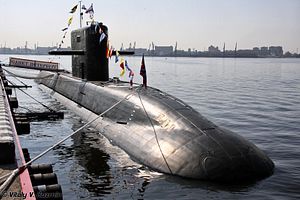The Russian Navy will not stop the construction of Project 677 Lada-class diesel-electric attack submarines, the Russian Navy Deputy Commander-in-Chief, Vice-Admiral Alexander Fedotenkov, told TASS in January.
“Following the results of the operational testing of the Kronstadt and Velikiye Luki submarines, the Navy will determine its further quantitative need for the Project 677 Lada. The termination of these submarines’ construction is not being considered at present,” the vice-admiral said.
He denied media reports that the Russian Navy will focus on the fifth-generation diesel-electric attack submarine Kalina project at the expense of the Lada-class.
The Russian Navy initially planned to field three Lada-class submarines by 2018. However, delays in the program have so far only lead to the service entry of the lead vessel of the class, the St. Petersburg in 2010, which has been undergoing operational evaluation ever since.
The St. Petersburg was already laid down in 1997 at the Admiralty Shipyard in St. Petersburg. Construction of its sister ships, the Kronstadt and Velikiy Luki began in 2005 and 2006 respectively, yet production of the two Lada-class subs was put on halt for some time and then restarted in 2013.
Russian Navy sources recently interviewed by IHS Jane’s Defense Weekly have said that the likely induction date will be 2019 “due account taken of the shortcomings revealed during the Northern Fleet’s operation of the Project 677 lead ship, St Petersburg.”
Initially, the new attack subs were slated to receive an air-independent propulsion system (AIP), but the Rubin Design Bureau, the main developer of submarines in Russia, has been struggling with the technology.
According to the head of the Russian Navy’s shipbuilding department, Captain (1st Rank) Vladimir Tryapichnikov, a new AIP system will not be ready until the early 2020s:
We presume that an AIP will be developed in the near future, and the Rubin Design Bureau has started such work recently. They have laid a good foundation … Rubin’s designers keep on working hard [to develop the AIP], and we believe it will be developed in 2021-2022.
As I report in this month’s The Diplomat Magazine, Delays in the construction of Lada-class submarines, recently led to the recent announcement that six Improved Kilo-class submarines will be built for the Pacific Fleet. These new vessels will most likely be fitted with Klub (Kalibr) submarine-launched anti-ship and land attack cruise missiles.
The Lada-class purportedly has a very low acoustic signature due a special anti-sonar coating called “Molniya” (“Lightning”) with some defense analysts referring to it as the ‘Mini-Red October class.’ (The sub displaces 2,700 metric tons when submerged and only needs a crew of 38 sailors to operate.)
The submarine is also equipped with an advanced sonar system, and features six torpedo tubes and specialized vertical missile silos for anti-ship and land attack cruise missiles. Its principal mission will be coastal defense against enemy submarines and surface vessels, surveillance and reconnaissance as well as intelligence gathering missions.
































